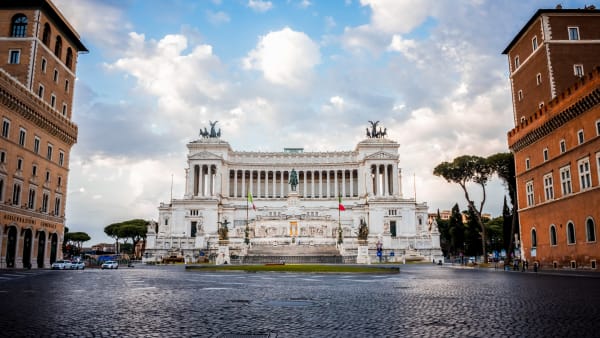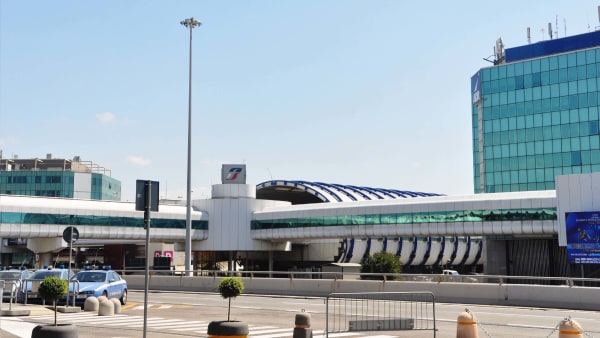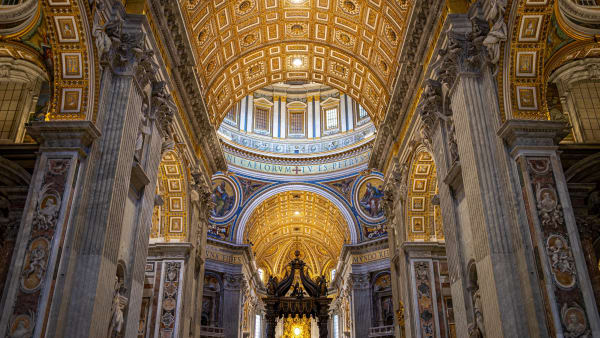Brief history
Brief history
In 54 AD, when Nero was seventeen years old, he became emperor of Rome. He was young, inexperienced, and eager to color outside the lines.
For instance, Nero dabbled in drama and loved poetry, singing, and music. As a singer, he also performed in public at some point. Although this was not appropriate for an emperor, he didn’t let it stop him. He was known for his exuberant and uninhibited lifestyle, which is reflected in the Golden House.
The rise of the Golden House
In the first years of his reign, Nero had the Domus Transitoria built. This part of the imperial palace was supposed to connect the area on the Palatine Hill with the imperial gardens of Maecenas on the Esquiline Hill.
After the Domus Transitoria was destroyed in the Great Fire, Nero had the Domus Aurea (the Golden House) built. Construction of the palace began after the fire in 64 AD and wasn’t completed until 68 AD when Emperor Nero took his own life.
Later, emperors rebuilt the massive complex and used it as the basis for other projects, such as the construction of Trajan’s Baths.
What the Golden House would have looked like
It’s said that Nero was inspired by the splendor of the villas in Campania and that his goal was to build the largest and most beautiful palace in the empire.
There are many statements in historical writings describing his ostentatious lifestyle. The Golden House is said to have reflected his decadent taste and need for luxury. Nero designed it solely for his entertainment and named it after its facade, which was decorated with marble and gold leaf.
Suetonius (Gaius Suetonius Tranquillus, a Roman writer and governor) described the palace as follows:
“In the hall of the Golden House stood a massive statue of Nero, measuring over 35 meters in height. The whole complex was so enormous that it had three colonnades of 1.6 km long.
An artificial lake was almost as big as the sea, surrounded by houses as large as cities. There were also mansions with fields, vineyards, plazas, meadows, and forests with wild and domestic animals of all kinds.
Some parts of the house were entirely gilded and decorated with gold, precious stones, and shells. In the dining rooms were movable ceilings of ivory, through which one could throw down flowers and spread perfume. The dome moved constantly by day and by night, like the universe. The baths in this room were filled with sea and sulfur water.
When Nero inaugurated the house, he expressed his great satisfaction, saying that he was finally living in a house worthy of a man.”
Impressive size and unique architecture
According to Elisabetta Segala, author of the book “Domus Aurea” published in 2005, the complex would have been a manifestation of power, as Nero aspired to a monarchy. This is very likely, as the entire complex of buildings stretched over an area on which the imposing building of the Colosseum would have fit 25 times.
The huge structure was less like a municipal palace and more like a vast estate. The Golden House is said to have had more than 300 rooms, which were reportedly decorated with precious ivory, ornate mosaics and frescoes, and large fountains.
Among the most architecturally spectacular aspects of the building were two dining halls that formed an octagonal hall, the vast complex center.
According to ancient writings, the domed ceiling had movable elements to throw blossoms, flower petals, and fragrances down on the guests. However, this hasn’t been proven archaeologically.
Location of the Golden House
Based on writings by the Roman historian Tacitus, it’s known that Emperor Nero had his palace built on an area of about 80 acres, which extended over the Palatine Hill, the entire valley of what is now the Colosseum, and parts of the surrounding hills of Caelio and Esquiline.
Nero’s Golden House’s present remains have been buried under Oppius Hill for nearly 2,000 years. The entrance to the underground ruins of the Domus Aurea is about 300 m northeast of the Colosseum (a 5-minute walk).
The end of the Domus Aurea
Nero had worked on the construction of his palace for only four years before his reign as emperor came to an end. He was declared an enemy of the state by the Senate and fled until he died in June 68 AD.
Thus, the foundation of the Domus Aurea was built in a relatively short period and was only used by Nero for a limited time. Nero’s successor Otho completed the palace. However, subsequent emperors Vespasian, Titus, and Trajan had parts of Nero’s palace torn down to have their palaces constructed on the site.
How the Colosseum got its name
In 72 AD, Emperor Vespasian had the Colosseum built on the site of the artificial lake. According to the legend, the palace had an impressive entrance with a colonnade on the side of the Roman Forum. This is where the huge statue (over 35 meters high) of Nero stood.
Today, the ruins of the Colosseum, whose name comes from this “colossal” statue of Nero, are located there.
Baths of Trajan
In 104 AD, a fire broke out in the residence building of the palace, damaging it considerably. Emperor Trajan then ordered the construction of the Baths of Trajan. Everything of value was removed from Nero’s magnificent Golden House and it became the base of the monumental baths.
The upper floor of the Domus Aurea was demolished and the lower floor was reinforced with walls. The basement was filled with earth, which is why it’s exceptionally well preserved to this day. This created a series of underground rooms with barrel vaults, which today are hidden under the earth of the hill.
The rediscovery of the Domus Aurea: an inspiration for the Renaissance
It took only forty years before the Domus Aurea was completely buried under newly constructed buildings. In the centuries that followed, Nero’s palace fell into oblivion and wasn’t rediscovered until the 15th century.
At the time of the Renaissance, rooms, and corridors were found by coincidence under the Baths of Trajan. The rediscovery of the imperial palace inspired artists such as Michelangelo, Ghirlandaio, Giulio Romano, Pinturicchio, and Raphael to descend into the vaults and illuminate the walls with torches.
They studied the ancient murals, frescoes, and decorations for inspiration. Their signatures in some places on the walls betrayed that they even copied frescoes.
Thus was born the “grotesque” painting style of the Renaissance, a 16th-century genre that reinterprets the historical motifs of Roman wall decoration. It’s based on the so-called “grotesques” or wall decorations showing people, plants, animals, and mythical creatures.
Resumption of excavations
It wasn’t until the end of the 18th century that further excavations took place. It’s said that academics became interested in the grotesque again after the frescoes of Pompeii were found.
Until the mid-19th century, about fifty rooms of the Domus Aurea were cleared in the years that followed. After that, at the beginning of the 20th century, the park “Colle Oppio” was constructed, containing the ruins of Trajan’s Baths and gardens.
In the 1950s, the excavations of the Domus Aurea resumed. It wasn’t until the 21st century that some of the halls were restored to the point where they could be opened to visitors. The extensive and costly excavation and restoration work on Nero’s palace remains far from complete and continues to this day.
The current state of the Golden House
Today, about 20% of the original building remains on Oppius Hill. The house was inhabited until it was destroyed by a fire in 104 AD. After this, the remains were integrated into the foundations of the Baths of Trajan and partially filled with stuffing material. Thus, many rooms were preserved underground.
Although debris and damp earth destroyed many frescoes, the sand protected the walls from moisture and ensured that some colors of the grotesque murals were preserved in excellent condition.
After decades of restoration, some halls of the Domus Aurea were opened to visitors in 1999. Due to the dramatic deterioration and difficult preservation of the building, a few years later, in 2005, it was closed again. Moreover, in 2010 a colonnade collapsed, so the ruins couldn’t be visited for a long time for safety reasons.
Since 2008, the DAI Rome has been working intensively on the conservation of the halls upon request of the Soprintendenza Archeologica di Roma (the Roman government antiquities service) and the Università La Sapienza. Therefore, in 2014, parts of the halls and frescoes were reopened to visitors.
Today, you can admire the ancient architecture and art of the palace during a guided tour through thirty different rooms. The ruins of Trajan’s baths still exist above these spaces and are often mistaken for remnants of the Domus Aurea.















